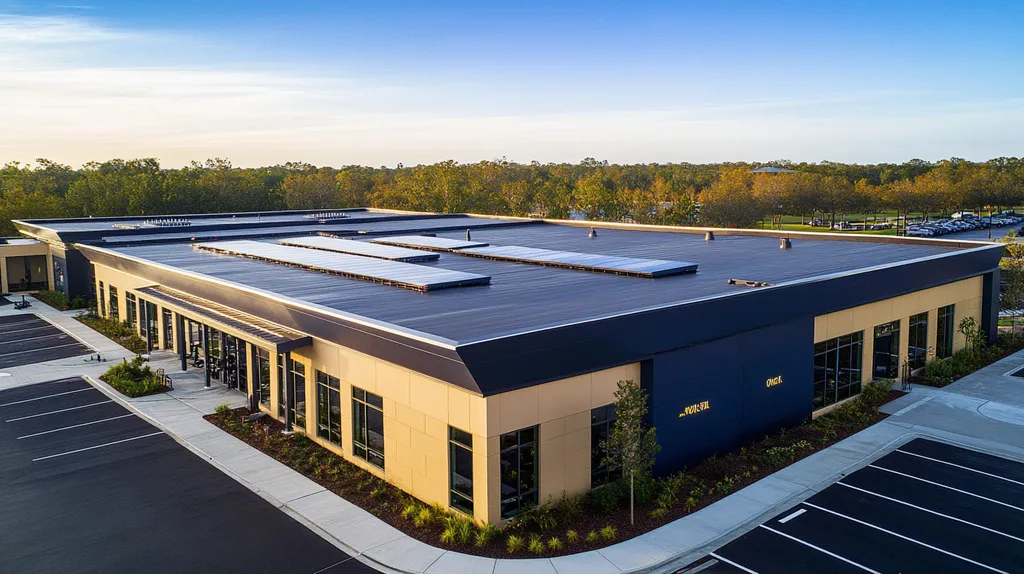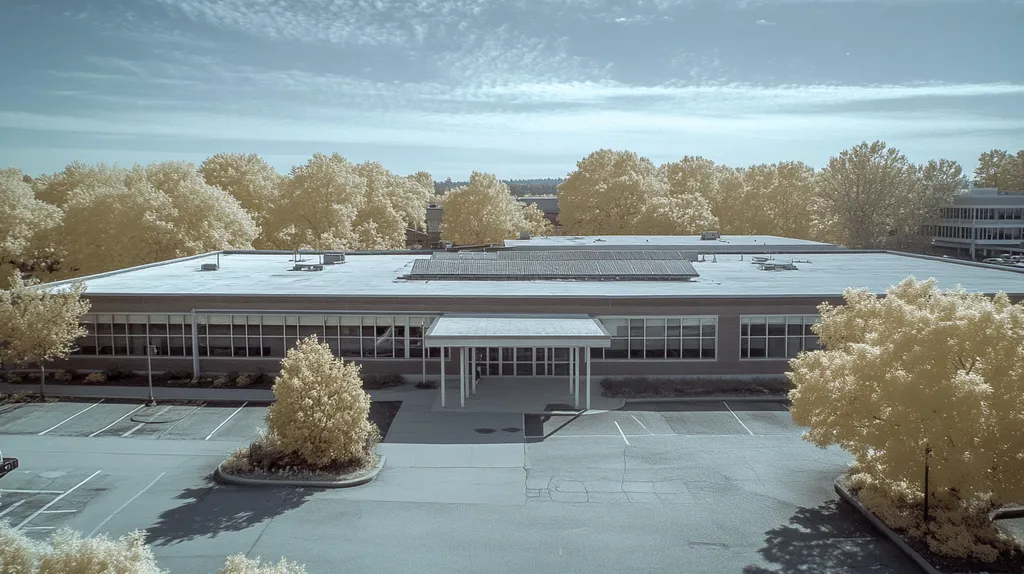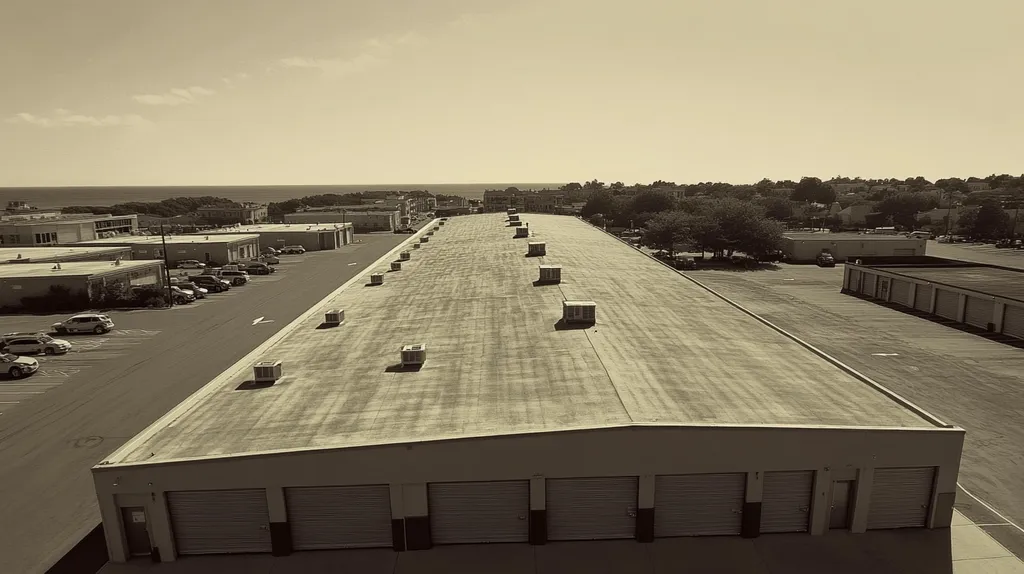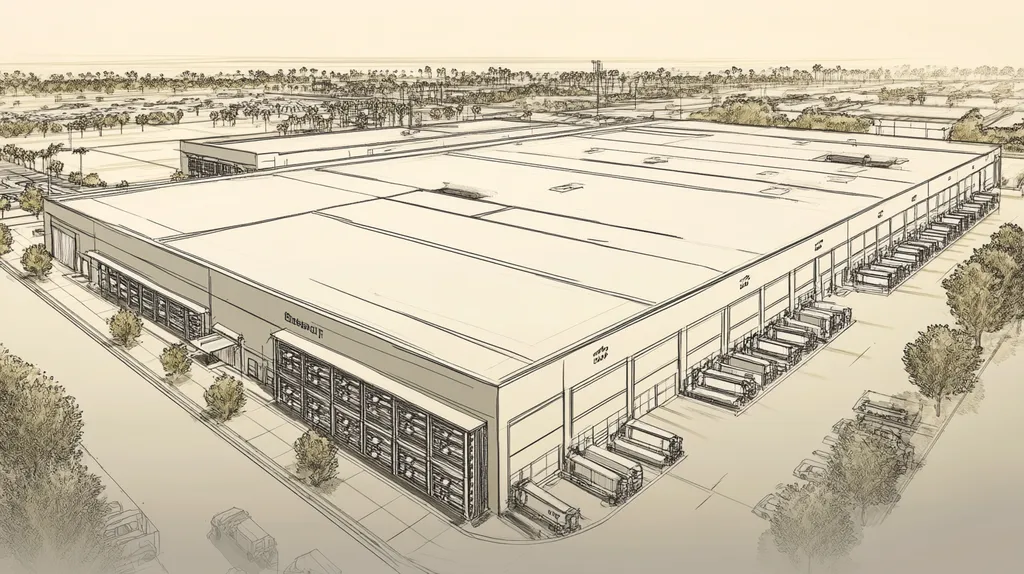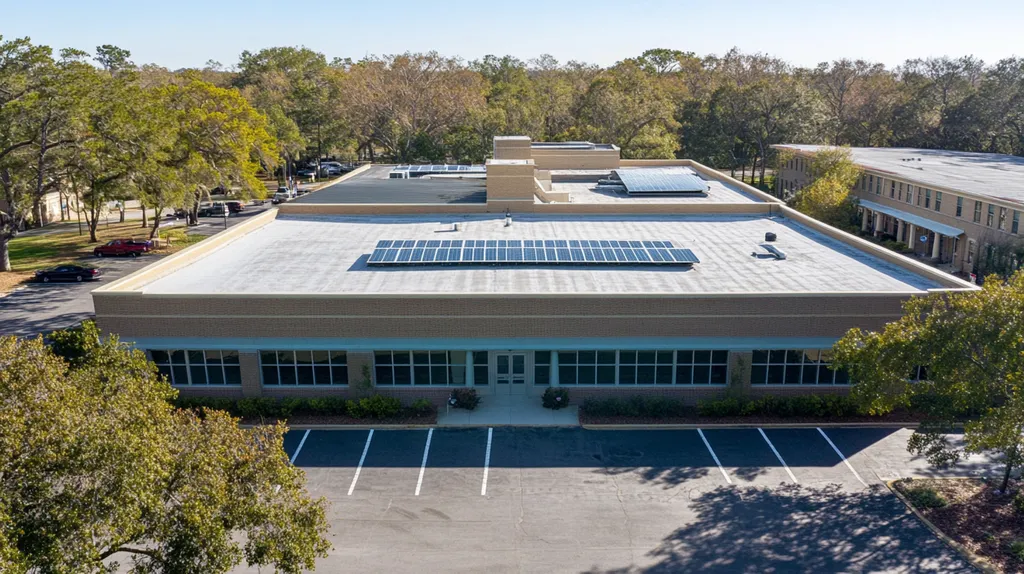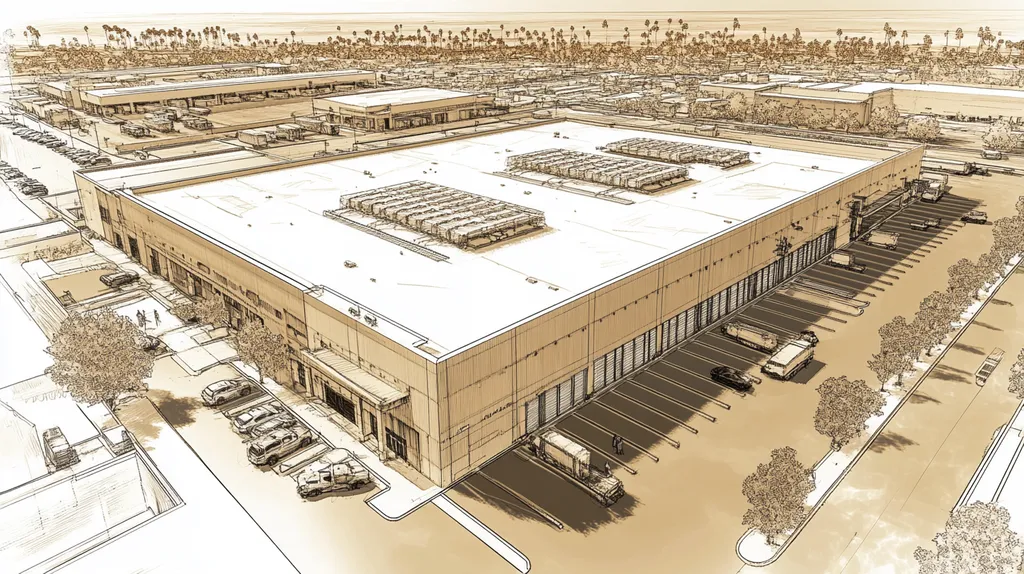In today’s industrial construction landscape, a misaligned roofing schedule can torpedo project timelines and send costs skyrocketing by up to 30%. With the average commercial roof replacement running $250,000 or more, the stakes couldn’t be higher.
Understanding how roofing work intersects with broader building schedules has become a make-or-break factor for project success. When trades clash or timelines conflict, delays cascade throughout the entire construction process.
This comprehensive guide breaks down the critical overlaps between roofing and building schedules, offering practical solutions for property owners and facility managers seeking to optimize their industrial projects.
SECTION 1: THE BASICS EXPLAINED
Understanding the overlap between building schedules and industrial roof work is crucial for a project’s success. In the U.S., delays in roofing can cost property owners thousands, disrupting operations and profits. Smart scheduling aligns roofing activities with construction timelines, reducing conflicts and ensuring safety regulations are met. After all, nobody wants their new roof to cause more headaches than it solves!
What It Is (In Plain Language)
The overlap between building schedules and industrial roof work is all about making sure roofing projects sync up with other construction work. Think of it as a well-choreographed dance—when one team goes out of step, it can throw everything off. For instance, if the roofing contractor jumps in before the structure is ready, it can lead to unnecessary damage and extra costs.
Effective scheduling goes beyond just timing; it’s about harmonizing each phase of construction to support the ones that follow. This involves coordinating deliveries, managing labor availability, and adhering to safety protocols. When roofing and construction teams communicate openly and share precise schedules, projects flow like a symphony, leading to fewer delays and unexpected costs.
Why It Matters (To Your Building)
Properly scheduling roofing work is vital to keeping construction sites safe and efficient. If roofing happens at the wrong moment, it can hinder other trades, causing costly delays. Imagine roofing equipment blocking access for electricians or plumbers—it’s a recipe for frustration and can lead to significant construction setbacks.
This kind of mismanagement can add up to 15% in extra expenses, placing a strain on your budget. Moreover, safety should always be the top priority. Overlapping contractors without a clear schedule increases the risk of accidents, which can lead to serious injuries or worse.
When roofing is timed right, it promotes smoother operations and helps facility managers achieve project goals without sacrificing safety or driving up costs. It’s a win-win that pays dividends down the line.
How It Works
Navigating the overlaps between roofing projects and overall building schedules requires savvy planning and solid communication. Typically, a project manager takes the lead in coordinating efforts, ensuring everyone is on the same page regarding timelines. Regular team meetings allow everyone to share updates, and adjust plans as needed.
Digital tools can also enhance collaboration by providing real-time visibility into project timelines. Project management software enables stakeholders to track the schedule, making it easier to adapt to unforeseen challenges. Clear milestones help keep everyone accountable and focused on moving forward.
It’s essential to anticipate potential complications like weather delays or material shortages to create a robust roofing schedule. By planning for possible roadblocks and developing contingency strategies, teams can minimize disruptions, keeping the project on track and within budget.
SECTION 2: PRACTICAL APPLICATIONS
The success of industrial roofing projects relies heavily on effective scheduling and seamless integration with other building activities. A misstep here can lead to significant losses, as an ill-timed roof installation might stall equipment deliveries or disrupt production schedules. Recognizing when and how roofing overlaps with other systems is essential: these interactions can either promote efficiency or create costly delays.
Common Uses & Examples
In various industrial settings, roofing work must be synchronized with ongoing construction efforts. Take a manufacturing facility, for example—here, roofing installation often coincides with the setup of new machinery. Timely coordination ensures that roofers complete their tasks without interfering with machinery installation or material logistics.
Retrofitting existing roofs presents another critical scenario where scheduling plays a key role. For energy-efficient upgrades, every phase must be meticulously timed to protect business operations below from disruption.
Moreover, roofing systems frequently interface with other essential building systems, such as HVAC or plumbing. A well-thought-out schedule means that roofing crews can do their work without running into delays caused by simultaneous tasks on these systems.
In short, successful roofing scheduling is about understanding and managing these overlaps to keep all construction activities in harmony。
When You Need It Most
Critical timing becomes paramount during peak operational periods. For instance, if a business expects a surge in production leading up to a holiday, scheduling roof work during that busy season can create unnecessary complications.
The most efficient roofing schedules often emerge during quieter business cycles. Planning roofing activities at these times minimizes disruptions while maximizing contractor productivity. By choosing off-peak periods, property managers can avoid overlapping schedules that might otherwise lead to financial headaches.
Seasonal weather must also be accounted for, as rain or snow can stall roofing projects. A thoughtful schedule that considers these variables helps ensure that roofing work finishes on time, come rain or shine.
With a keen understanding of ideal scheduling, property owners can safeguard their investments and streamline the building process effectively.
Interactions With Other Systems
Roofing systems operate in close connection with other building components, making coordination essential. For example, linking roofing installation with HVAC work requires clear communication among contractors to prevent any conflicts that could delay the project or result in costly repairs.
Poorly coordinated roofing efforts can compromise the efficiency of utility installations. If plumbing runs through the roof, it’s crucial for the roofing work to align with other trades; otherwise, alterations could lead to leaks or damage to the underlying systems.
In industrial environments, safety is paramount, and the interplay between roofing work and fire safety systems requires meticulous planning. Delays in roof installation can disrupt access for essential inspections or maintenance of fire suppression systems.
By acknowledging the critical interactions between roofing systems and other building elements, facility managers can cultivate a smoother and more efficient project flow. This holistic approach is a vital recipe for project success.
SECTION 3: KEY TERMINOLOGY DECODED
Grasping roofing terminology is essential for anyone involved in industrial projects. Misinterpretations can spiral into costly delays and shoddy installations. Familiarity with key terms can illuminate how to effectively integrate roofing schedules with broader construction timelines. When property owners and facility managers understand the language of roofing, they’re better equipped to make informed decisions, paving the way for smoother project execution.
Essential Terms Explained
In roofing discussions, you’ll often hear terms like “deck,” “membrane,” and “flashing.” The “deck” is the strong structural base of the roof that supports everything else. The “membrane” serves as the waterproof layer, guarding the building against leaks. “Flashing,” on the other hand, is the protective material used at seams and around features like vents. Misunderstanding these terms can jeopardize the entire project.
Another critical term is “drainage.” An effective drainage system is vital for managing water runoff. If water pools on the roof, it can lead to serious wear and need costly repairs down the road. Knowing how drainage systems are designed can save property owners future headaches.
Also, understanding “life cycle cost” is key—it refers to the overall cost of ownership over a roof’s lifespan, including installation, maintenance, and repair. This term aids in making side-by-side comparisons of roofing materials and systems, ultimately highlighting potential long-term savings.
By becoming familiar with these essential terms, property owners and facility managers can communicate effectively with roofing professionals, boosting the chances of a successful project.
Industry Jargon Translated
The roofing industry has its own set of specific jargon that might puzzle those not in the trade. For example, “R-value” measures thermal resistance. A higher R-value means better insulation, resulting in lower energy costs. Understanding this term is crucial when evaluating roofing options for energy efficiency.
Another term you might encounter is “field area,” which describes the main section of the roof where materials are installed, excluding edges and penetrations. Knowing this distinction is essential when calculating material needs and managing costs.
By breaking down this jargon, stakeholders can eliminate confusion and engage more productively in discussions about project timelines and budgets.
Measurement & Units Simplified
In roofing, precise measurements are paramount. The term “square” is commonly used, representing an area of 100 square feet. Understanding this unit is vital for calculating material requirements and costs. Miscalculating squares can result in shortages or excesses, jeopardizing the project timeline.
A related term is “pitch,” which describes how steep a roof is, usually expressed as a ratio of vertical rise to horizontal run. Knowing the pitch is essential for ensuring proper drainage and optimizing energy efficiency. Incorrect assumptions about pitch can lead to choosing unsuitable materials.
Lastly, consider the “gutter flow rate,” which indicates how quickly water can be channeled away from a roof. This rate is crucial to avoid water damage. Knowing the necessary flow rate helps property owners choose the appropriate gutter systems.
Errors in measurements and units can significantly affect project success and financial outcomes. Mastering this terminology empowers property owners and facility managers to engage actively and effectively in roofing discussions and decision-making processes.
SECTION 4: DECISION FACTORS
Making informed decisions about industrial roofing isn’t just a wise choice—it’s a crucial factor that directly influences the overall success of a project. With the average industrial roof replacement costing between $5 and $12 per square foot, every budgeting or planning miscalculation can lead down a slippery slope of financial strain. Property owners and facility managers must carefully balance cost considerations, performance trade-offs, and durability factors against the unforgiving timelines of construction schedules. By grasping these decision factors, they can align roofing projects seamlessly with broader construction activities, paving the way for smoother project execution.
Cost Considerations
The financial implications of industrial roofing decisions are undeniably significant. While initial installation costs might steal the spotlight, it’s critical not to overlook future expenses lurking in the shadows. A budget-conscious manager might be tempted to pick the cheaper materials, oblivious to the potential for higher maintenance costs down the line.
Take, for instance, a low-cost single-ply membrane. It might offer immediate savings but risk frequent repairs or premature replacement, creating a false sense of economy that weighs on future budgets. Clearing this fog of misunderstanding is vital—delays in roofing can disrupt not only the projected timeline but also escalate labor costs and prolonged deadlines.
Ultimately, selecting roofing solutions requires striking the right balance between upfront expenditures and long-term performance. This strategic alignment safeguards the investment against unexpected financial pitfalls.
Performance Trade-offs
The choice of roofing materials can dramatically influence the performance of a facility. Opting for roofing solutions with superior insulation properties can lead to sizeable reductions in energy costs, translating into improved building efficiency.
Yet, it’s essential to recognize that high-performance materials often come with a steeper price tag. Facility managers must assess whether these performance trade-offs align with their safety and efficiency objectives. For example, a roof engineered to endure harsh weather may demand a higher investment upfront but significantly diminish the risk of long-term business disruptions.
Additionally, managers should consider warranty options when selecting materials. Some roofing systems come with extended warranties, reflecting a manufacturer’s confidence in their long-term performance, providing an extra layer of security for your investment.
By evaluating these performance factors with intention, decision-makers can optimize energy efficiency while ensuring the roofing system meets their operational demands.
Lifespan & Durability Factors
Lifespan and durability are critical components of any roofing project. Given that industrial roofs are subject to relentless environmental challenges, property owners must prioritize longevity. While cost-effective materials might seem appealing initially, they often lack the durability that extended use necessitates, leading to frequent replacements.
For instance, although a 15-year warranty might look enticing, a deeper dive into the historical performance of similar materials in comparable conditions is crucial. High-quality roofs can last over three decades, yielding significant savings across their lifespan.
Local climate and environmental impacts also play an essential role in roofing decisions. If a region frequently experiences severe weather, stronger roofing solutions become non-negotiable, underscoring the need for durability in every roofing strategy.
Investing in high-performance roofing systems not only boosts resistance against damage but also enhances the structure’s overall longevity, ultimately leading to better financial returns for property owners.
SECTION 5: COMMON CHALLENGES
When roofing work gets tangled in the scheduling web of building projects, it can lead to costly delays and unforeseen expenses. A striking 60% of construction delays stem from ineffective scheduling practices. In fast-paced industrial environments, tackling these challenges head-on is essential for project success. This section examines typical issues that arise in roofing coordination, highlights warning signs to watch for, and offers preventative strategies to streamline operations and enhance productivity.
Frequent Problems & Solutions
One prevalent challenge arises from miscommunication between roofing crews and other contractors. This can lead to overlapping work schedules, which inevitably causes delays. To counter this, establishing clear communication channels at the outset is vital. Regular scheduling meetings that include all stakeholders help ensure everyone remains aligned and informed.
Unexpected weather conditions can also wreak havoc on roofing plans, bringing work to a standstill and driving up costs. Utilizing weather tracking tools and building in flexibility within the schedule can significantly mitigate these unpredictable setbacks, allowing teams to adapt as necessary.
Furthermore, inadequate site preparation can stall installation efforts. If the site isn’t fully readied, the roofing team may waste valuable time and resources. Conducting thorough site assessments before roofing begins confirms that all aspects are in place, ensuring a smoother installation process.
Warning Signs To Watch For
Facilities managers must stay alert for indicators of scheduling conflicts, like overlapping activities among contractors on-site. When multiple teams operate simultaneously, chaos can ensue, resulting in inefficiencies. Regularly reviewing the project calendar can help pinpoint these overlaps early on and prevent them from escalating.
A decline in communication frequency among teams is another red flag. If updates aren’t being shared regularly, it could signal potential disruptions ahead. Instituting frequent check-ins fosters open lines of communication and diminishes the likelihood of confusion.
Moreover, sudden fluctuations in worker availability can hint at deeper scheduling challenges. Frequent absences or overbooked crew members threaten project timelines. Diligently monitoring worker schedules allows for timely adjustments, ensuring continuity and momentum in construction efforts.
Preventative Approaches
To avert disruptions, integrating roofing schedules within the broader building timeline is essential. This comprehensive approach ensures seamless coordination among all trades involved. Scheduling software can enhance visibility and facilitate more efficient resource allocation, contributing to smoother operations.
Creating a detailed checklist before roofing starts can ensure that all preparations are complete. This checklist should confirm that materials are delivered on-site and that safety measures, like scaffolding, are in place. By minimizing the risk of overlooked tasks, roofing projects can proceed with greater efficiency.
Lastly, it’s crucial to develop robust contingency plans. Preparing for potential obstacles enables proactive management of any challenges that may arise. By anticipating hurdles and devising backup strategies, facility managers can navigate the complexities of roofing projects with grace and confidence.
SECTION 6: NEXT STEPS & RESOURCES
Navigating the complexities of roof scheduling is a critical element in any industrial project. With construction delays capable of costing businesses up to $1.2 million every day, every second truly matters. By thoroughly evaluating roofing needs and timelines, stakeholders can significantly reduce disruptions and increase the lifespan of their assets. This section outlines essential resources and key questions to engage roofing providers effectively, ensuring alignment with industry standards and best practices.
Questions To Ask Providers
When interacting with a roofing provider, asking the right questions is vital to align your project with its timelines. Begin by inquiring about their experience with industrial projects similar to yours. A solid track record can reveal their reliability, so request examples of previous projects they completed on time and within budget.
Next, discuss their familiarity with essential building schedules. It’s crucial to understand how they plan to coordinate with other contractors to avoid overlaps and conflicting timelines. Their approach to project management can reveal how they prioritize your roofing project amid a sea of commitments.
Be sure to ask about their contingency plans in case of weather delays or any unexpected issues. Knowing how they prepare for such eventualities will give you insight into their level of preparedness and reliability.
Finally, clarify the anticipated timeline for each roofing project phase. This ensures that everyone is on the same page regarding critical overlaps and allows the roofing work to mesh seamlessly with other construction activities.
Industry Standards & Guidelines
Grasping industry standards is essential for optimizing roof scheduling. Organizations like the National Roofing Contractors Association (NRCA) offer extensive guidelines on best practices for roofing installation and maintenance. Adhering to these standards ensures high-quality work while reducing future headaches.
Familiarization with the National Institute of Standards and Technology (NIST) protocols can streamline scheduling by ensuring that roofing work complies with overall building codes. This step is essential for meeting required safety and performance criteria.
Moreover, being aware of Occupational Safety and Health Administration (OSHA) guidelines for workplace safety during roof installation can help reduce risks dramatically. Compliance not only protects personnel but also minimizes potential liabilities for your organization.
Consulting these important resources can facilitate better planning and coordination among contractors. This, in turn, leads to a smoother workflow, helping to prevent costly delays caused by inadequate preparation.
Further Learning Simplified
Staying informed is crucial in the ever-evolving roofing industry. Numerous online platforms offer courses focused on roof project management and scheduling, helping facility managers stay updated on the latest technologies and methods.
Professional organizations frequently host webinars discussing critical issues, including case studies and innovative roofing strategies. Participating in these events provides valuable insights from industry leaders that can sharpen your decision-making skills.
Subscribing to industry publications can help stakeholders stay on top of market trends and emerging practices, enhancing their roofing choices. This ongoing education is essential for navigating the complexities of roofing projects effectively.
Finally, engaging with peers through industry forums can foster knowledge sharing, allowing property owners and facility managers to learn from one another’s experiences and successfully tackle intricate roofing challenges.
The Bottom Line
With industrial roofing costs continuing to rise 8-12% annually, mastering schedule coordination has never been more critical for project success.
The ripple effects of poor timing between roofing work and building schedules can increase total project costs by up to 30% while creating unsafe conditions for workers and occupants alike.
By understanding critical overlaps, maintaining clear communication channels, and leveraging industry resources, facility managers can significantly reduce delays and costly disruptions.
The future of industrial roofing depends on this careful orchestration of schedules, trades, and timelines.
Those who master these scheduling intricacies will find themselves ahead of the curve, protecting both their investments and their building occupants for years to come.
FREQUENTLY ASKED QUESTIONS
Q. What is the overlap between commercial roof schedules and construction work?
A. The overlap refers to how roofing projects synchronize with other construction phases. A well-timed schedule prevents delays and costly errors, ensuring that roofing doesn’t start too early, which can lead to damage or wasted resources. Clear communication between teams is vital to keep everything flowing smoothly.
Q. How can I improve scheduling for my industrial roof projects?
A. To improve scheduling, coordinate roofing work with other trades, ensuring no overlap leads to downtime. Conduct regular meetings with all stakeholders to review timelines. Additionally, consider using scheduling software for better visibility and real-time updates to adapt to any changes or disruptions.
Q. What key roofing terms should I understand for my industrial roof?
A. Key terms include “deck” (the structural base), “membrane” (the waterproof layer), and “flashing” (for protection at seams). Understanding these basics helps prevent miscommunication with contractors and ensures your roofing project runs smoothly and effectively.
Q. What factors should I consider when choosing a commercial roof?
A. Consider factors like cost, performance longevity, and suitability for your building’s function. While upfront costs matter, think about future maintenance expenses and whether the materials can endure local weather conditions. Finding the right balance will safeguard your investment.
Q. What common challenges arise in scheduling for industrial roofing?
A. Common challenges include miscommunication between teams and unexpected weather interruptions. Poor scheduling can lead to overlapping tasks that stall progress. Regular communication, weather awareness, and thorough site preparation are vital for overcoming these obstacles and keeping the project on track.
Q. How can I engage roofing providers effectively?
A. Ask about their previous experience with similar projects, their approach to scheduling, and how they handle unexpected delays. Discuss timelines for different roofing phases to ensure everything aligns with your overall construction plans. Clear dialogue leads to smoother outcomes.
Q. How do seasonal changes affect scheduling for commercial roofs?
A. Seasonal changes can impact weather conditions, influencing roofing timelines. Scheduling work during off-peak periods minimizes disruptions and enhances contractor productivity. By anticipating potential weather-related setbacks, you can create a schedule that ensures projects are completed on time, regardless of the season.

